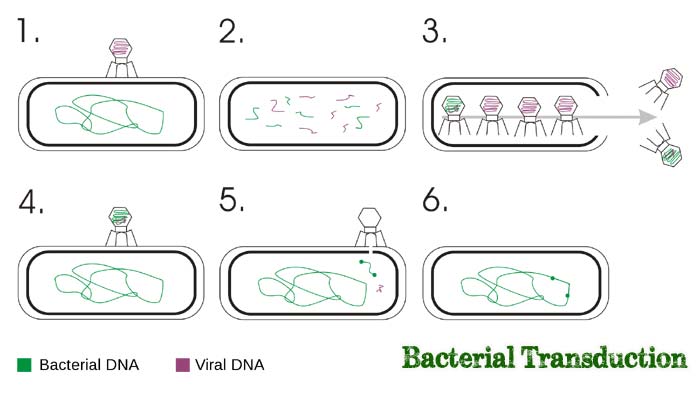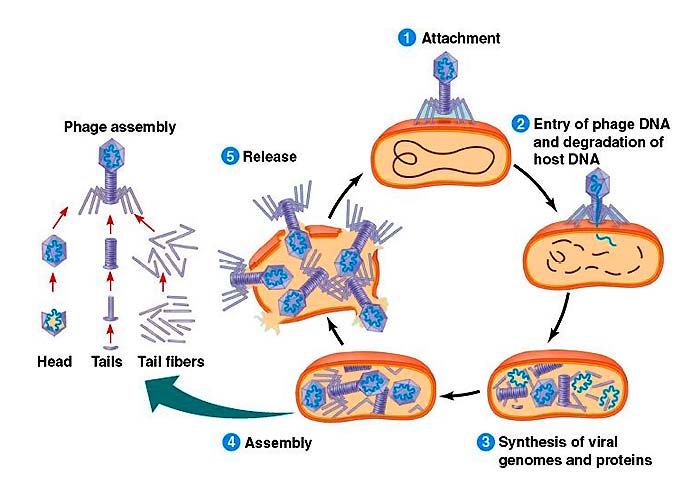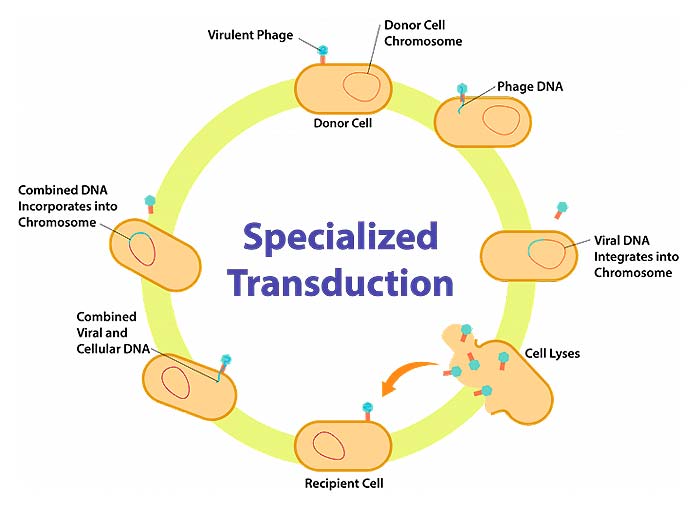Bacterial Transduction: A Mode of Genetic Recombination
Even without contact, bacterial cells can transfer their genetic material to other cells through bacterial transduction. Explore how this event is possible in this article.

Bacterial Transduction: Have you ever wondered if you can have a certain genetic trait obtained from another organism? Well, that though is still not plausible but in the world of microorganisms, that is definitely possible. Let’s explore more about this mode of gene transfer below.
Jump to:
- What is Bacterial Transduction?
- Discovery of Transduction
- Types of Transduction
- 1. Generalized Transduction (Lytic Cycle)
- 2. Specialized Transduction (Lysogenic Cycle)
- Applications of Bacterial Transduction
- 1. Mapping of Bacterial Genes
- 2. Contributes To The Increase of Genetic Diversity
- 3. Serves As A Key To Antibiotic Resistance
- References
What is Bacterial Transduction?
Bacterial transduction, or simply transduction, is a type of gene transfer where a bacterium transfers its DNA (or a portion of it) to another bacterium (that is not its offspring) by using a virus as a vector. Unlike other processes of gene transfer like horizontal gene transfer and conjugation, transduction does not require the physical contact between the host cell and the cell that will donate the DNA.
- In viruses, transduction occurs through either the lytic cycle or the lysogenic cycle, depending on the type of virus itself.
- During the lytic cycle, the virus penetrates through the penetration of the cell membrane and DNA replication process whereas during the lysogenic cycle, the virus fuses its DNA with the host.
![]()
Discovery of Transduction

The discovery of the process of transduction was traced back in 1952 when scientists Norton Zinder and Joshua Lederberg were studying the recombination in the bacterium Salmonella typhimurium. The researchers grew two different strains of the bacterium (one was met− his−, and the other was phe− trp− tyr−) on a medium with less nutritional components and when observed, no wild-type was found. Zinder and Lederberg, however, found out that when the two bacteria were combined, wild-type cells appeared.
- However, the researchers also found some “recombinants” (organisms with one or more segments or genes have been inserted into their DNA) in the culture.
- By preventing cell contact with filters of varying sizes, the researchers found the one responsible for the rise of the recombinants–a temperate bacteriophage of Salmonella.
- So instead of confirming the conjugation in the bacterium, the researchers discovered a new process of gene transfer in organisms, and this time, mediated by a virus.
![]()
Types of Transduction
While transduction is very common among bacteria, there are actually two kinds: generalized and specialized tranduction. The two are further elaborated below.
1. Generalized Transduction (Lytic Cycle)

This is a method of transduction that allows genes to be transferred from one bacterium to the other. This happens when a virus accidentally transfers its genetic material, the same way it infects animal cells & plant cells, and other bacterial cells.
- Virus (or bacterial phages, in this case) cannot replicate their own DNA; thus, they infect a host cell and take over the machinery to replicate their own. When it is done, parts of the virus are aggregated and released to infect other cells.
- To complete the process, parts of the host chromosomes must be destroyed and needs to be reassembled for the viral DNA to be inserted.
- Due to random chances of infection, the viral DNA is not inserted but the DNA of its previous host bacterial cell. And if any recombination happens in the cell with the new set of genes that is when you call the process of generalized transduction.
- This type of transduction occurs during the lytic cycle of the virus where it invades and incorporates its own DNA to the host’s. Eventually, the virus will kill its host by bursting the cell (hence lysis). New viral cells are then ready to infect other cells.
![]()
2. Specialized Transduction (Lysogenic Cycle)

As it name suggests, this kind of transduction involves the specific insertion of the viral DNA to the host cell.
- Specialized transduction occurs in the life cycle of the virus and involves an additional phase that somehow is different from the typical life cycle. In particular, it occurs during the lysogenic sequence of viral infection.
- As a result, a specific spot on the host’s chromosome gets inserted with bacterial chromosome.
- In order to complete the cycle, the virus then re-undergoes the lytic cycle in order to transfer the genes to a new cell.
- In contrast with generalized transduction, the viral DNA do not immediately kills the host cell. Instead, it goes dormant as it inserts its own DNA to the host and allows it to grow while the viral DNA gets replicated. Soon, the virus will reactivate its machinery and eventually kill the host.
![]()
Applications of Bacterial Transduction
The process of bacterial transduction is very essential not only for bacteria and viruses but for living organisms in general. Below are the reasons why.
1. Mapping of Bacterial Genes
The amount of DNA packaged inside the head of the virus is largely dependent on the size of the head itself. The cutting of the host chromosome is done randomly, with all genes having the same probability of being packaged and transmitted to the vector.
- Hence, the closer the genes are to each other, the higher chance of them being packaged in the same fragment of DNA.
- Thus, bacterial genes can be mapped by calculating their frequencies of being transduced.
![]()
2. Contributes To The Increase of Genetic Diversity
The process of bacterial transduction generally increases genetic diversity. This is very important as it allows organisms to adapt to any changes in their environment.
- Gene recombination is also one of the fundamental cores of the very process of evolution.
![]()
3. Serves As A Key To Antibiotic Resistance
At present, the phenomenon of antibiotic resistance is becoming widespread. Transduction is specifically important as it can explain the mechanism by which antibiotics become ineffective because of the transfer of the genes among bacteria.
- A lot of present studies are now gearing towards combating this phenomenon.
![]()
Sure you have heard about songs or videos going viral. Where do you think that metaphor came from?
![]()
Cite this page
Bio Explorer. (2026, January 8). Bacterial Transduction: A Mode of Genetic Recombination. https://www.bioexplorer.net/bacterial-transduction.html/
References
- Images are from wikimedia under the creative commons licenses
- “Genetic Transfer in Prokaryotes | Boundless Microbiology”. Accessed December 17, 2017. Link.
- “Transduction – An Introduction to Genetic Analysis – NCBI Bookshelf”. Accessed December 17, 2017. Link.
- “An Introduction to Recombinant DNA”. Accessed December 17, 2017. Link.
- “Phage Consultants”. Accessed December 17, 2017. Link.
- “Generalized Transduction | MICRB 106”. Accessed December 17, 2017. Link.
- “Transduction – Uses In Research – Chromosome, Genetic, Dna, and Genes – JRank Articles”. Accessed December 17, 2017. Link.
- “Microbial Genetics | Microbiology”. Accessed December 17, 2017. Link.





